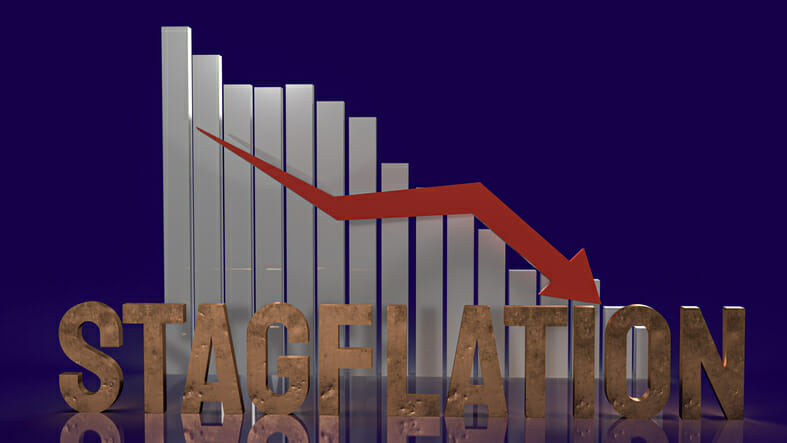Stagflation is the worst of both worlds. It occurs when the economy is both in a recession and inflation is rising. This means that people earn less but spend more on basic goods and services. Stagflation is rare, but when it happens you’ll need to know how best to invest for your portfolio. If you take the time to develop a stagflation investing strategy it can make it easier to weather even the most challenging economic environments. .
A financial advisor could help you create a financial plan for your investment needs and goals.
What Is Stagflation?
Stagflation is a period of economic stagnation, when growth slows and unemployment rises, combined with high inflation. Demand for goods and services may decline as income levels drop and we experience high inflation. This compounds the problem as the income that people do have is diminished by higher prices.
Recessions and inflation tend to happen separately. In U.S. history, there have been two marked stagflation periods, one in the early 1970s and another that took place in the late 70s to early 1980s. Meanwhile, there have been more than a dozen recessions since the Great Depression.
Generally, stagflation is bad for consumers because you’re making less money and everything costs more. For investors, stagflation typically means lower returns as growth slows. The longer stagflation goes on, the more significant the impact to the future value of your portfolio may be.
What Is Stagflation Investing?
Stagflation investing is essentially a defensive approach to managing an investment portfolio to minimize the risks of rising prices and a shrinking economy. Developing an investment strategy for stagflation means:
- Identifying investments that are more likely to be insulated against the effects of rising inflation and slowing economic growth
- Understanding which market sectors or investments have the best odds of outperforming during a downturn
- Diversifying your portfolio to minimize the risk of stagflation-related loses
Another key part of investing for stagflation is understanding that it isn’t likely to last forever. While your portfolio may take a hit in the near term, it’s possible to recover if you have a long-term investment strategy in place and you’re staying the course through different market cycles.
Best Investments for Stagflation
Some investments may fare better than others when the economy becomes stagnant and inflation is on the rise. Reevaluating your portfolio can help you decide which investments to include, and which ones you may want to leave out until stagflation ends.
Here are five common options that you might consider for stagflation investing:
- Real estate. Real estate investments tend to have a low correlation with stocks and people still need housing during an economic slowdown. Rental prices usually move with inflation and sometimes outpace it, even when the value of the dollar drops.
- Value stocks. Value stocks are stocks that are undervalued by the market. These stocks may be bargain buys when stock prices are lower due to stagflation. The key is to avoid value traps, which are stocks that appear to be undervalued but actually are not.
- Gold and silver. Gold is often used as a hedge against inflation since its value tends to increase even as the value of other currencies drop. While investments in gold and other precious metals may not generate income, they can help to offset stock market risk during stagflation periods.
- Commodities. Commodities are the raw materials that are used to make other products. During stagflation, agriculture and oil commodities, in particular, may be poised to outperform stocks and bonds.
- Cryptocurrency. Cryptocurrency is still very much a mixed bag in terms of risk and rewards but it’s an alternative asset you might consider during stagflation. It’s important, however, to consider how much risk you’re willing to take since the crypto market is highly volatile.
You may also consider defensive stocks as a stagflation hedge. Defensive stocks can offer more insulation against slower economic growth and high prices since they’re associated with things consumers still need to spend money on. So you might move some of your portfolio into stocks in the consumer staples sector or healthcare to limit the impacts of stagflation.
What to Avoid When Investing for Stagflation

Some investments are more sensitive to stagflation, so you may want to approach these three with caution if you’re concerned about where the economy is headed:
- Growth stocks. When economic growth slows, growth companies may react by pulling back on expansion plans. Slower growth can negatively affect prices for those stocks and the associated returns from those investments.
- Bonds. Bonds and bond funds tend to lose some of their luster during stagflation because higher prices erode the purchasing power of the future currency they generate. Foreign bonds may do better than domestic bonds when stagflation sets in.
- Cash and cash equivalents. Cash and cash equivalent investments face the same problem as bonds during periods of stagflation. The returns they generate may not be enough to keep up with rising consumer prices, siphoning away purchasing power.
While these investments may not be ideal for stagflation, they can still play a part in your portfolio. Rather than cutting them out altogether, you may consider changing up your asset allocation so that you’re favoring stagflation-friendly investments. Once stagflation begins to ease, you can then reassess your portfolio and reallocate assets as needed to stay aligned with your investment goals.
Other Ways to Prepare Your Portfolio for Stagflation
Aside from rethinking your investments, there are other things to take into consideration if stagflation is on the horizon. For example, it’s important to look at the fees you’re paying to invest.
If you believe investment returns may drop, then it’s to your advantage to reduce fees as much as possible. So that might mean moving out of more expensive mutual funds into lower-cost exchange-traded funds (ETFs). Or you may switch your trading account to a brokerage that charges less in commissions or service fees.
Also, consider the overall diversification of your portfolio. Diversification simply means spreading out your investment dollars in order to spread out risk. The more diversified you are with different investments, the more you may be able to protect yourself against the worst impacts of stagflation.
Historical Lessons From Past Stagflation
Stagflation is rare, but it has happened before, most notably in the 1970s and early 1980s, and history offers valuable lessons for investors.
In the 1970s, the U.S. economy faced skyrocketing prices in the oil markets, rising inflation, and slowing growth. Inflation peaked at over 13% in 1979, and unemployment climbed, creating a challenging environment for both consumers and investors. During this period, traditional stock and bond portfolios struggled.
Here’s what performed best:
- Commodities like oil and agricultural goods rose significantly as prices increased.
- Gold and precious metals surged, with gold climbing from around $35 an ounce in 1971 to over $800 by 1980, making it a popular hedge against inflation.
- Real estate also held up relatively well, as property values and rents often kept pace with inflation.
And what struggled the most:
- Growth stocks underperformed as higher interest rates and slower corporate earnings weighed on prices.
- Long-term bonds suffered as rising inflation eroded the real value of fixed payments.
Once the Federal Reserve tamed inflation in the early 1980s by raising interest rates sharply, the economy eventually stabilized. Investors who stayed the course and maintained a diversified portfolio saw markets recover strongly in the years that followed.
The takeaway? While stagflation can hurt short-term returns, maintaining a mix of assets — including those that historically perform well during inflation — and avoiding panic selling can help investors weather the storm and position their portfolios for recovery when growth resumes.
Bottom Line

Stagflation investing may not be your typical approach but it’s important to know how to adapt if this phenomenon comes along. And you can use the strategies learned by investing for stagflation to help strengthen your portfolio against future recessionary environments and the longer-term impacts of sustained high inflation. A financial advisor can provide additional insights on the market environment, and which strategies are best suited for the moment.
Investing Tips
- Consider talking to a financial advisor about the best ways to invest for stagflation. SmartAsset’s free tool matches you with up to three financial advisors who serve your area, and you can interview your advisor matches at no cost to decide which one is right for you. If you’re ready to find an advisor who can help you achieve your financial goals, get started now.
- When investing for stagflation, remember to consider all of your investments, including those held in a 401(k) or IRA as well as the money you’ve invested through a taxable brokerage account. If you don’t have a brokerage account yet, you may consider opening one to expand your investment horizons beyond mutual funds or ETFs. There are a number of online brokerages that offer fee-free stock trades with low initial deposit requirements, making it easy to get started with trading.
Photo credit: ©iStock.com/damircudic, ©iStock.com/Pekic, ©iStock.com/niphon
